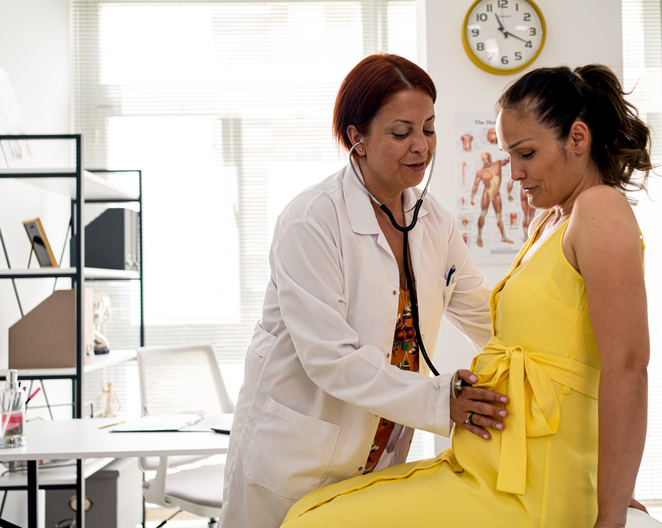What’s the True Cost of Having a Baby in America?

In light of the uncertainty surrounding the overturning of Roe v. Wade, we thought it prudent to examine the actual cost of having a baby in the United States. It is an unequivocal fact that raising and caring for a child is expensive. Parents must pay for clothing, toys, child care, extracurricular activities, diapers, formula, food, baby gear, school supplies, etc. But the cost of raising a child in America begins long before birth, and the initial costs depend on a pregnant woman’s access to prenatal healthcare, postpartum medical care, and well-baby visits.
In addition to the costs for appointments and baby supplies, most parents pay hefty monthly premiums to maintain their health insurance coverage.
To showcase how drastically costs can change based on where you live and what insurance you have, I will share my own experiences. My first child was born in Washington, D.C., where I worked at a private preschool for a government agency. As a result, I had one of the best insurance policies available in the country. My total costs for giving birth, including prenatal appointments, labor, and delivery, was $300.
Compare that to my second child, born in Chicago, where I worked for a non-profit preschool and had decent insurance. I paid $30 for each prenatal visit; labor and delivery charges were approximately $2,000. So overall, my cost was around $2,600.
My two kids were born via vaginal delivery, with an epidural and inducement, almost three years apart, but resulted in two very different costs.
The costs mentioned above were only the medical costs for me. The figures don't include co-pays for well-baby visits or baby gear like strollers, car seats, cribs, diapers, wipes, clothing, bottles, or a breast pump. The numbers also exclude child care costs, copays for sick visits, and money lost due to time off for maternity leave and sick days.
Related: Can You Afford Another Child?
The USDA estimates that a child born in 2015 will cost parents $233,610 between birth and age 18. Now multiple that by two, three, or even four children. New parents are often shocked by the sticker price a baby costs, and even middle-income families struggle at times to afford items.
Approximate Costs:
- Housing $3,750 annually
- Food $2,794 annually
- Childcare/Education $37,400 total
- Transportation $1,947
- Other (Healthcare, extracurricular, clothing, misc.) $2,856
The cost of raising a child is one reason the US has seen a steady decline in its birthrate since 2008. In addition, the COVID pandemic has lowered that rate further. However, financial experts predict with the overturning of Roe vs. Wade, the U.S. will see an increase of over 150,000 births a year, including a significant increase in births that require a high level of care (18,400-19,600) and pre-term births (17,300-18,400).
Prenatal Costs

As my personal example above shows, having health insurance is no guarantee that having a baby will be inexpensive, although in most cases, it will drastically reduce the cost from those uninsured. Unfortunately, the United States does not consider healthcare a right and therefore has no universal healthcare system. As a result, insurance coverage and premiums vary significantly from company to company and plan to plan.
Proper prenatal care is essential for both the health of the mother and the baby. However, women who become pregnant unexpectedly or who don’t have health insurance often miss or skip vital doctor appointments.
The average, low-risk pregnancy will have approximately 15-20 prenatal visits; expect a few more if you’re expecting multiples or a potential problem is discovered. Depending on your health insurance plan, your coinsurance could range from free to $25, $40, or even $50 per visit. Some plans also have deductibles that members must meet before paying anything, so you could pay out of pocket for your first several check-ups.
In addition to prenatal checkups, you will need prenatal vitamins and access to healthy food, and you must have a car seat installed correctly in your car before leaving the hospital with your new baby.
If you are returning to work post-birth, securing a spot at a daycare or childcare facility must happen nearly the moment you discover your pregnancy. To secure a spot, parents are often asked to deposit hundreds if not thousands of dollars, sometimes prepaying for the first month or two.
The Cost of Giving Birth

The actual cost of childbirth in the united states depends on the type of delivery, where you live, the length of your hospital stay, and how much your insurance covers if you have it.
The average hospital bill for giving birth with health insurance in the United States is around $2,000 to $4,000, with a total cost between $5,000 -$10,000 for the entire pregnancy. Cesareans, especially emergency procedures, cost even more.
The cost without insurance is drastically steeper, with the average vaginal delivery costing $11,000 and a C-section birth $13,000. However, uninsured costs could be much higher depending on where you live. For example, vaginal birth in New York without insurance costs over $13,600, and C-sections begin at $17,000.
Add in the cost of doctor’s visits for routine maternity care and postnatal appointments, unexpected medical costs, and well-baby visits for the first year, and the cost of having a baby can easily reach $30,000 or more if uninsured.
Most insurance policies that cover pregnancy also cover your baby and their medical needs for the first few days and sometimes weeks of life. It is essential to read your policy carefully and see how soon you need to add your baby to it to ensure their care is covered.
Average Costs Around Nation Without Insurance
Below are a few of the average costs to give birth in different states. To see your state's average, click here.
- Alabama - $15,162
- Alaska - $18,748.
- Arkansas - $15,005
- California - $26,380
- Delaware - $11,391
- Hawaii - $12,139
- Maryland - $8,934
- Maine - $9,623
- Michigan - $12,711
- Nebraska - $8,805
- New Jersey - $29,048
- Ohio - $15,149
- Pennsylvania - $19,764
- Tennessee - $13,261
- Washington D.C. - $21,243
Cost of Vaginal Delivery Around the World with Health Insurance
All countries below have universal healthcare, so while the cost of birth may be comparable to the United States, many individuals are paying costly premiums in addition to the cost of labor and delivery. The U.S. is the only developed nation without universal healthcare, leaving more than 27.5 million people uninsured annually.
- Argentina - $2,237
- Australia - $5,312
- Canada - $3,195
- France - $2,500
- Germany - $2,500
- Hong Kong - $12,000
- Mexico - $600
- Spain - $1,950
- Switzerland - $7,751
- Thailand - $2,000
- United Kingdom - $2,300
Finding Affordable Healthcare
If you are planning on becoming pregnant, read your health care policy closely to see what is covered. If you or your partner recently started a new job, check when the health insurance becomes active. Some employers don’t cover you until you’ve worked there for three months or more. If the policy is under your partner and you are not married, make sure they cover domestic partnerships.
Depending on your financial status, you may be eligible for Medicaid. Medicaid covers the cost of your prenatal checkups and labor and delivery if covered. If your income is too high for Medicaid, your children may still be eligible for CHIP. CHIP covers your child’s healthcare costs until their 19th birthday as long as you continue to meet the eligibility requirements.
WIC is another social program for pregnant, postpartum, and nursing mothers and children from birth to age five. WIC helps low-income mothers access healthy food for themselves and their children as well as breastfeeding support.
The Impact of Unexpected Babies on the Economy

It doesn’t matter how you feel about the recent Roe vs. Wade decision; the recent changes to the law are going to affect the economy and have drastic financial consequences for mothers; especially young, unwed, lower-income mothers who are no longer able to make a decision about their bodies and what is best for their family.
With less safe, affordable, and reliable access to abortion, the workforce will be depleted by mothers who choose or need to stay home to care for babies and cannot afford childcare. Women who did not have access to abortion are three times as likely to leave the workforce. It is also much harder for a woman to find a job if she is visibly pregnant.
According to the Institute for Women’s Policy, an estimated 505,000 women annually will be depleted from the workforce resulting in a loss of over $3 billion in revenue that could be going back into the economy.
As a result of the loss in work, mothers and families will have less to spend on clothing, food, and household goods, not to mention luxury expenditures like vacations and new cars, which slows down the economy.
Even if these women can return to work, they lose an average of 37% of their earning power when they take three or more years off.
Women who lose their job due to pregnancy are also more likely to become victims of domestic violence and are stuck being financially dependent on their abusive partners.
Social Impact of Having More Children

An economic impact is not the only struggle the country will face with an uptick in unexpected pregnancies. Social systems like foster care, SNAP, WIC, and schools will all be faced with an increased demand for services as more and more low-cost families become eligible for benefits when a woman loses or is forced to leave her job. Experts agree that having access to abortion lowers poverty rates and reduces neglect and abuse.
Many of these unplanned pregnancies will occur in poverty-stricken communities, and more struggling children will put a strain on low-income school districts. In addition, 76% of the teaching workforce is female. So the overturning of Roe vs. Wade could significantly impact the already struggling schools' teaching staff available. But unfortunately, it is also likely to lead to an uptick in teen pregnancies.
Gillian Sealey, the chief of staff at Power to Decide, formerly the National Campaign to Prevent Teenage and Unplanned Pregnancy, said in response to the ruling, “We do know that if a student, whether in high school or even at the college level, has an unplanned pregnancy, that definitely impacts them furthering their education and then can have devastating consequences for their economic upward mobility.”
Whether or not you agree with the overturning of Roe vs. Wade, the evidence is clear. An increase fo unplanned pregnancies will strain the economy, low-income families, the school system, and our social services. Having a child is a major decision and one that should be thought through, planned, and prepared for whenever possible.
That’s not to say an unexpected pregnancy cannot bring joy to your life because it certainly can, but having a baby in America is indeed an expensive investment.

